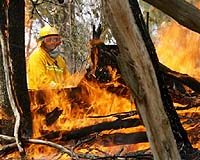| . |  |
. |
Leeds, UK (SPX) Jul 30, 2009 The area of forest burnt by wildfires in the United States is set to increase by over 50% by 2050, according to research by climate scientists. The study predicts that the worst affected areas will be the forests in the Pacific Northwest and the Rocky Mountains, where the area of forest destroyed by wildfire is predicted to increase by 78% and 175% respectively. The research is based on a conservative temperature increase of 1.6 degrees Celsius over the next 40 years. Published in the Journal of Geophysical Research, scientists also say that the increase in wildfires will lead to significant deterioration of the air quality in the western United States due to greater presence of smoke. "Wildfires, such as those in California earlier this year, are a serious problem in the United States and this research shows that climate change is going to make things significantly worse," says Dr Dominick Spracklen, from the School of Earth and Environment at the University of Leeds who is the lead author of the research. "Our research shows that wildfires are strongly influenced by temperature. Hotter temperatures lead to dryer forests resulting in larger and more serious fires," explains Spracklen. "In the Rocky Mountains we are predicting that the area burnt by wildfires will almost triple by 2050." Scientists used data documenting the area of forest burned on federal land since 1980 along with weather data from the United States Department of Agriculture Forest Service, to construct a computer model that takes into account the factors that can best predict the area burned in each ecosystem in the western US. Significantly, the research also predicts a 40% increase in the western United States in the concentration of tiny soot particles in the air, known to scientists as organic carbon aerosol. This will have important consequences on western US air quality and visibility. "The US government has introduced legislation to try to improve air quality and visibility by 2064. Currently the main focus for environment agencies and campaigners is industry, but this research shows that, especially in the western US, wildfires will become an increasing source of air pollution," explains Dr Spracklen. This work was funded by the U.S. Environmental Protection Agency (EPA) and National Aeronautics and Space Administration. Dr Dominick Spracklen carried out the research whilst at Harvard's School of Engineering and Applied Sciences (SEAS) in collaboration with Jennifer Logan and Loretta Mickley. Share This Article With Planet Earth
Related Links University of Leeds Forest and Wild Fires - News, Science and Technology
 Australia's deadly wildfires worse next year: officials
Australia's deadly wildfires worse next year: officialsMelbourne (AFP) July 29, 2009 Australian officials on Wednesday warned the country could be hit by even worse wildfires next summer than the deadly blazes which killed a record 173 people in February. Victoria state premier John Brumby said the fire season could be the toughest in a decade, after a leaked report warned of a "worst-case" situation prompted by an expected El Nino weather pattern. "The prognosis in term ... read more |
|
| The content herein, unless otherwise known to be public domain, are Copyright 1995-2009 - SpaceDaily. AFP and UPI Wire Stories are copyright Agence France-Presse and United Press International. ESA Portal Reports are copyright European Space Agency. All NASA sourced material is public domain. Additional copyrights may apply in whole or part to other bona fide parties. Advertising does not imply endorsement,agreement or approval of any opinions, statements or information provided by SpaceDaily on any Web page published or hosted by SpaceDaily. Privacy Statement |